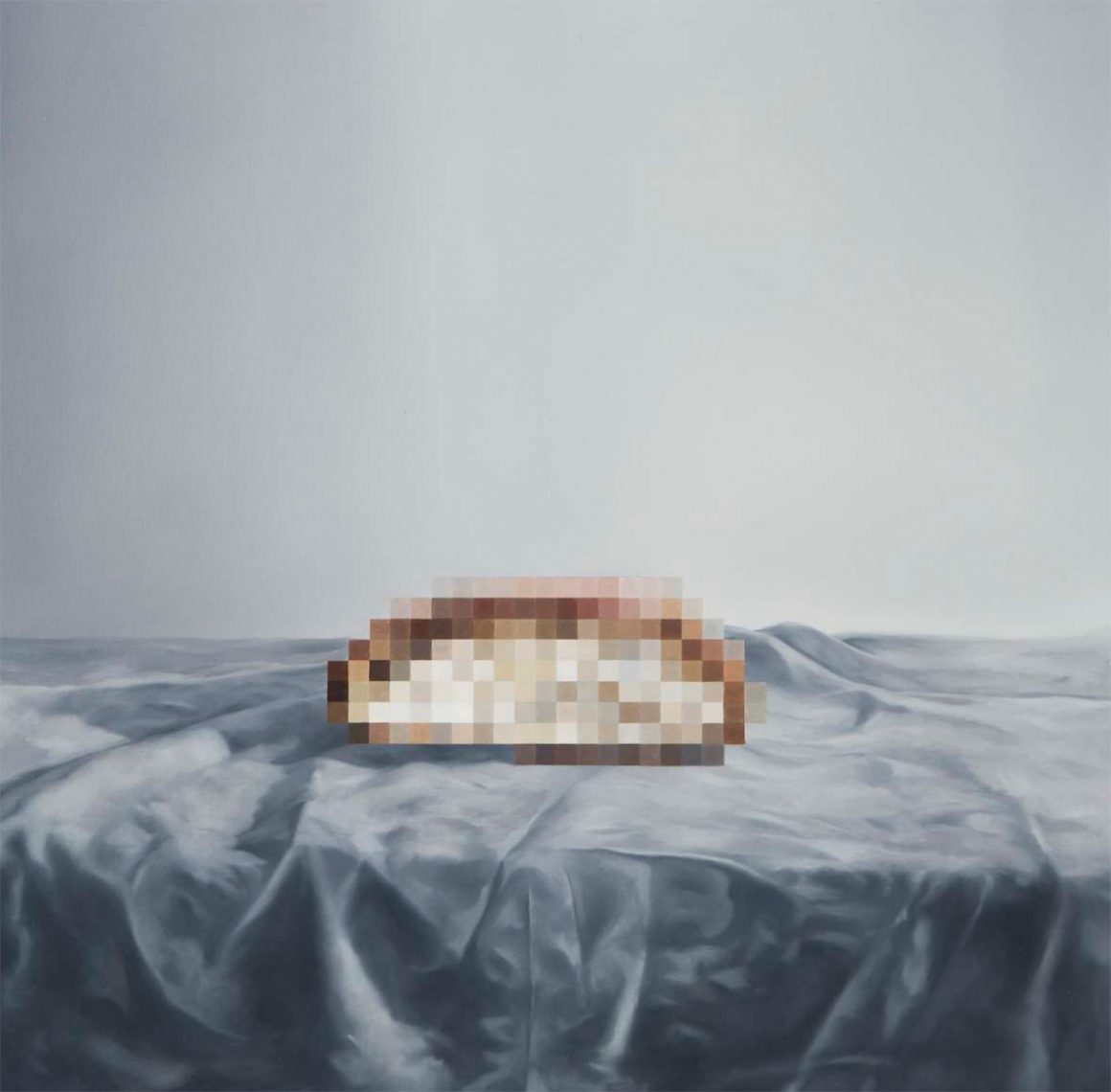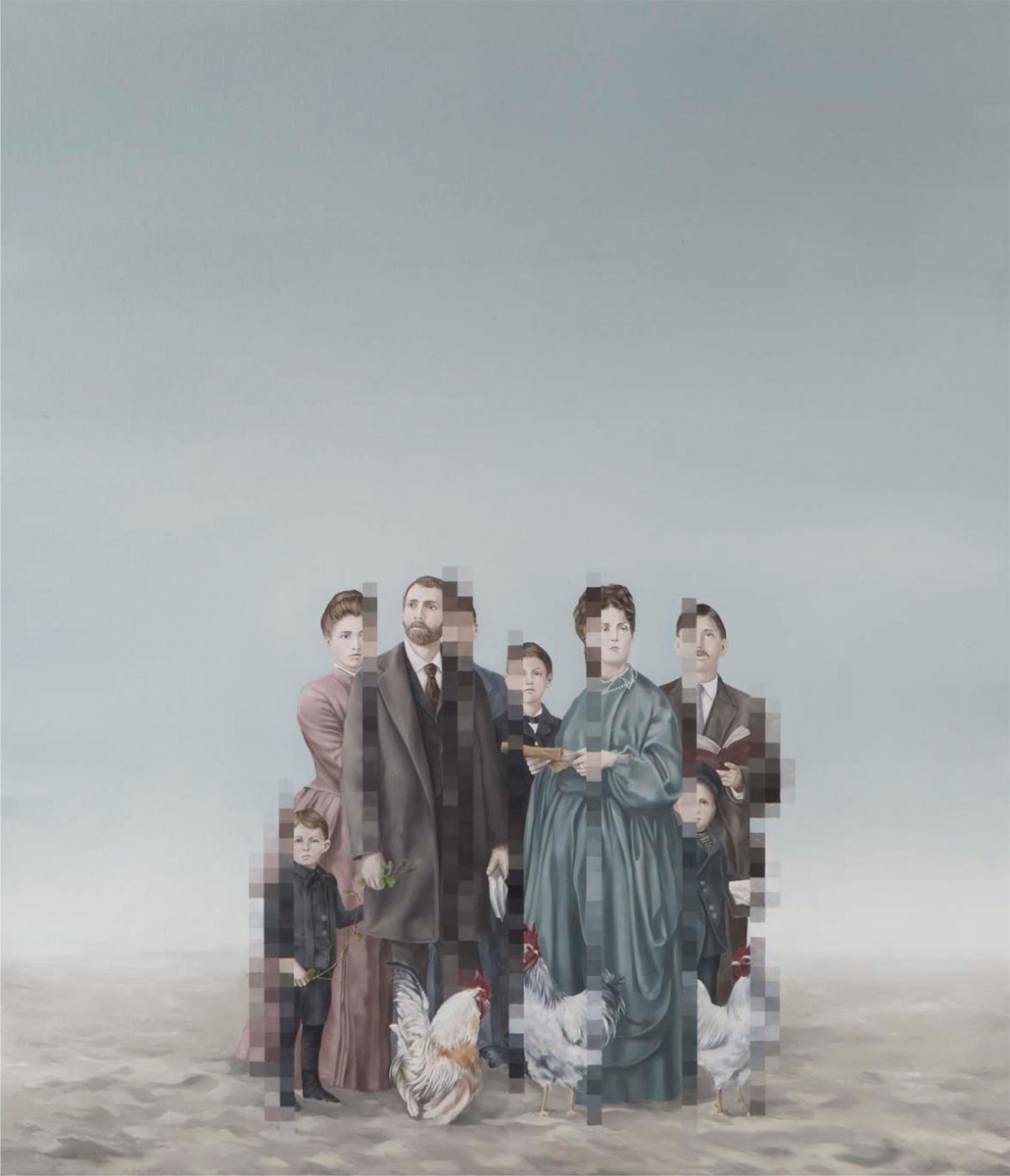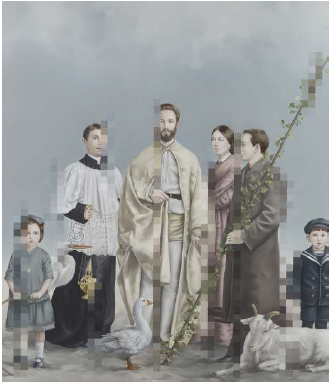PIXELATED MYSTERIES
A conversation with artist Aldo Sergio. Interview by Stephanie Chan

L’altare – The Altar 65x65cm, oil on linen, 2017

Atto Secondo – Second Act, oil on linen, 80x70cm 2017
Aldo Sergio’s paintings are punctuated with a peculiar
modern feature — pixelation. A still life rendering of fruit in a bowl is suddenly obfuscated, as though some unknown censor frowns upon green apples or pears. In a staid portrait of a family, each member sports a stripe of every colour. A horse lies on its side, dead or perhaps resting, an ethereal beacon of pixelated light streaming
from its body into the sky seemingly transferring some kind of data to the heavens. By introducing pixelation into traditional portraits,
Sergio resets the process of painting itself. He shows the colours that are the building blocks of each subject. Sometimes the painting gives the impression that it
hasn’t finished loading, like in the early days of the internet when images would slowly come into blurry focus. his interrupts the viewer’s perception of the
work, forcing them to ill in the blanks and, in some cases, to consider the inner workings of the subjects.
Adding this kind of ‘glitch’ to the portrayal of a subject highlights the inescapable fact that humans are also a kind of machine, processing the environment around
them as a series of inputs with mysterious implications.
In Sergio’s work, the landscape is received as input by the
artist — the ocean’s ininitely variable blues and greens
— and is interpreted through a painting that brims with
new insight and metaphor. And the cycle begins anew
with the viewer.
he interplay between the natural and synthetic
introduces a simmering tension. he uncanniness of
inding a digital artifact in the real world turns everything
into a series of symbols. he Virgin Mary is recognizable when blurred out, but she is reduced to a sign of divinity rather than a figure. But rather than stripping away the
emotion associated with these figures, the paintings now act as a kind of Rorschach test, and heighten viewers’ interpretations.
On he Shore shows a woman confronted by a child represented in only blocks of colour. Or perhaps it is not a child at all. hen the viewer is forced to consider why it
is that the child is pixelated. Does this reflect the woman’s
attitude toward the figure? Is the figure not even there, instead representing something that happened long ago, its features lost to the ebb of time? We ind out more about this intriguing artist.
Can you tell me a little more about yourself
and your background?
Aldo Sergio: I was born in Salerno, in southern Italy. I always felt a natural need to paint. After art school I decided to study anthropology to expand my vision of reality.
Where do you find inspiration for your paintings?
Aldo Sergio: For me, inspiration is something that comes from within
and that often becomes an obsession; it is in a moment of mental silence
that it takes shape.
Your work seems to convey a sense of dry humour
— is that something you want to communicate to the viewer?
Aldo Sergio: I think that irony has the ability to strengthen a concept
and at the same time make it more accessible and less frightening. It
allows the public to approach and to think about my work.
What does the pixelation represent to you?
Aldo Sergio: he pixels alter the image and this allows me to put
a certain distance between the public and the work. On the other
hand, the igurative elements draw the observer in. In a way it’s a metaphor of life, where no understanding is possible except from a certain distance. his is just one interpretation — the sense of what I do is constantly changing,
even for me, and I have only to gain from that.
How do you choose which aspect of the subject to pixelate? In some, it seems to only be part of their body while in others, it’s the whole of them.
Aldo Sergio: My work articulates itself through various levels of alteration
of the image — through processes of decomposition, magnification, fragmentation. I alternate between underlining and omission. The constant theme is the coexistence of doubt and certainty.

Atto Primo – First Act, oil on linen, 110x170cm 2017 (detail)
What is the relationship between your work and technology?
Sergio: In the past few years, my paintings have been strongly influenced by technology, more or less consciously; even just by the simple fact that most of
the images that we consume every day are projected on
screens and composed of pixels.
You seem to come back to religious subjects and the natural world time and again. Why are you drawn to these themes?
Aldo Sergio: It may not seem so at first, but my work often has a minimalist approach. I am constantly trying to get rid of the superfluous and trying to define the human existence by stripping reality down to its core. At the end, it seems to come down to nature and spirit. This seems to be the universal equation.
In some of your paintings, like Second Act, I’m reminded of colour swatches and of breaking down subjects into their essential colours. Is this your intention?
Aldo Sergio: In some paintings, like Second Act or First Act, the pixels have the symbolic function of uniting, or rather, of merging all the subjects between them, as if they were seams. he human figures, the animals, the
sky and the earth are all connected by the palette of
colours they all share.
How do you choose which colours you want to work with?
Aldo Sergio: The colours I choose have the same
importance as the subject matter. I often think that
the origin of the choice of colours that an artist uses is
influenced by where they live. When I lived close to the
sea, I felt the need to use more blues, greens, grays, in
more saturated shades; I think in a way it’s giving back,
through the painting, what our eyes have taken in.
What is the essential element in your paintings?
Aldo Sergio: The mystery.

Natura morta – still life I 50 x 60 cm, olio su lino 2016
This editorial was part of our 4th printed issue. You can get your copy here.



